Demographics of Kerala
Kerala is a state in south-western India. Most of Kerala's 34.8 million people (in 2011) are ethnically Malayalis (Malayalam speakers). Most of the Malayalam and English speaking Keralites derive their ancestry from Dravidian communities that settled in Kerala. Additional ancestries derive from millennia of trade links across the Arabian Sea, whereby people of Arab, Jewish, Syrian, Portuguese, English and other ethnicities settled in Kerala. Many of these immigrants intermarried with native Malayalam speakers resulting in formation of many Muslims and Christians in Kerala.[1][2] Some Muslims and Christians thus take lineage from Middle Eastern and European settlers mixed with local population.
| Demographics of Kerala | |
|---|---|
.png.webp) Population pyramid taken from the 2011 census | |
| Population | 34.8 million |
| Density | 859 per sq.km |
| Growth rate | 3.31% yearly (2021 estimate) |
| Life expectancy | |
| • male | 75 years |
| • female | 80.15 years |
| Fertility rate | 1.82 births per woman |
| Infant mortality rate | 7 per 1000 live births |
| Net migration rate | -0.08 per 1000 (2019 estimate) |
| Age structure | |
| 0–14 years | 19% |
| 15–64 years | 70% |
| 65 and over | 12% |
| Sex ratio | |
| Total | 0.97 males/female |
| At birth | 1.04 males/female |
Malayalam is Kerala's official language and is spoken by at least 97% of the people of Kerala; the next most common languages are English and Tamil which is spoken mainly by migrant workers from the neighbouring state of Tamil Nadu. Tulu and Kannada is spoken in northern parts of Kasaragod district, bordering Karnataka. In addition, Kerala is home to 321,000 indigenous tribal Adivasis (1.10% of the populace).[3] Some 63% of tribals reside in the eastern districts of Wayanad (where 35.82% are tribals), Palakkad (1.02%), and Idukki (15.66%).[4] These groups, including the Paniyars, Mooppans, Irulars, Kurumbars, and Mudugars,[5] speak their own native languages.[6][7][8] Cholanaikkan tribe in the Silent Valley National Park were contacted only in the 1970s and they are the most isolated tribe in the state.[9]
Population
| Population density of Kerala | |
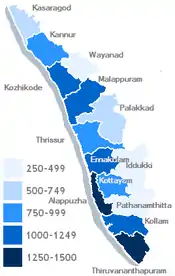 | |
| Kerala's districts, shaded by population density (inhabitants per km2) | |
| Source:[10] | |
Kerala is home to 2.76% of India's population, and at 859 persons per km2;[11] its land is three times as densely settled as the rest of India. Kerala's western coastal regions are the most densely settled with population of 2,022 persons per km2, 2.5 times the overall population density of the state, 859 persons per km2, leaving the eastern hills and mountains comparatively sparsely populated.[12] However, Kerala's population growth rate is far lower than the national average, although Kerala's population more than doubled between 1951 and 1991 – adding 15.6 million people to reach a total of 29.1 million residents in 1991 – the population stood at 31.8 million by 2001 and 33.3 million in 2011.[11] Kerala's people are most densely settled in the coastal region, leaving the eastern hills and mountains comparatively sparsely populated. Kerala is the second-most urbanised major state in the country with 47.7% urban population according to the 2011 Census of India.[13]
Hinduism is followed by the majority of Keralites (54.7%). The major religions followed in Kerala are Hinduism (54.7% — Hinduism in Kerala), Islam (26.6%) and Christianity (18.4%).[14]
Kerala also had a tiny Jewish population until recently, said to date from 587 BC when they fled the occupation of Jerusalem by Nebuchadnezzar.[15] The 2001 Indian census recorded only 51 Jews in Kerala. The synagogue in Kochi is the oldest in the Commonwealth of Nations.
The state has many famous temples, mosques, and churches. The oldest church in India is found in Kerala, believed to be established by St. Thomas, the disciple of Jesus Christ and the Cheramaan Juma Mosque is considered to be the oldest mosque in the Indian subcontinent which was built by an Islamic missionary Malik Dinar.
| Year | Population | Decadal growth |
|---|---|---|
| 2011 | 33,406,061 | 4.91 |
| 2001 | 31,841,374 | 9.43 |
| 1991 | 29,098,518 | 14.32 |
| 1981 | 25,453,680 | 19.24 |
| 1971 | 21,347,375 | 26.29 |
| 1961 | 16,903,715 | 24.76 |
| 1951 | 13,549,118 | 22.82 |
| 1941 | 11,031,541 | 16.04 |
| 1931 | 9,507,050 | 21.85 |
| 1921 | 7,802,127 | 9.16 |
| 1911 | 7,147,673 | 11.75 |
| 1901 | 6,392,620 | – |
Population graph of Kerala from 1910 to 2011
Source:[16]
Features
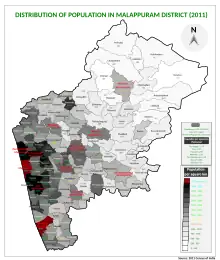
Social development
Kerala ranks highest in India with respect to social development indices such as elimination of poverty, primary education and healthcare. This resulted from significant efforts begun in 1911 by the erstwhile Princely states of Cochin and Travancore to boost healthcare and education among the people and aided by the Christian missionaries. This central focus – deemed unusual in India – was then maintained after Kerala's post-independence inauguration as a state.[19] Thus, Kerala has the highest literacy rate in India of 93.91% (2011);[20] and life expectancy is now the highest in India. The suicide rates in Kerala are the highest in India.[21] As per the 2011 census, Kerala and Puducherry are the only domiciles in India with a female-to-male ratio higher than 0.99. The ratio for Kerala is 1.084 – 1084 females per 1000 males – while the national figure is 0.940.[22] It is also one of the states in India to have sub-replacement fertility.[23]
UNICEF and the World Health Organization (WHO) designated Kerala as the world's first "baby-friendly state" via its "Baby Friendly Hospital Initiative". The state is also known for Ayurveda, a traditional system of medicine – this traditional expertise is currently drawing increasing numbers of medical tourists. However, drawbacks to this situation includes the population's steady ageing – indeed, 11.2% of Keralites are age 60 or over.[19]
Kerala's unusual socioeconomic and demographic situation was summarised by author and environmentalist Bill McKibben:[24]
Expatriation and Emigration
As of 2011, a total of 2,280,000 Keralites reside outside India. Largest populations are found in UAE (883,313) and USA (680,076).[25]
The major concentrations of expat Keralites are in the following nations: (figures as of 2011)[26]
Diversity
There are more than 2,500,000 migrants living in Kerala,[27] mostly from Assam and West Bengal, constituting more than 8% of the population. There are also migrants from Bihar, Jharkhand, Chhattisgarh, Orissa, and the North East.[28][27][29]
Studies indicate that by the time of 2026 state elections, migrants will become a crucial voting block in many of the constituencies in Thiruvananthapuram, Kollam, Kochi, Kozhikode, Thrissur and Kannur districts.[30]
Lists
Urban centres
According to 2011 Census of India, Kerala has six 1.5 million-plus urban agglomerations: Kochi, Kozhikode, Thrissur, Malappuram, Thiruvananthapuram, and Kannur, all of which has a population of at least 1.5 million.[31][32][33] Over a third of Keralites live in these large cities (a higher percentage than any other state), and over half the population lives in urban centres.[34]
Largest cities or towns in Kerala 2011 Census of India[35] As per the population within their respective Municipal Corporation/Municipality limits | |||||||||
|---|---|---|---|---|---|---|---|---|---|
| Rank | District | Pop. | |||||||
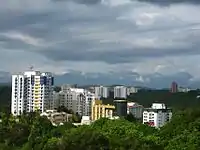 Thiruvananthapuram 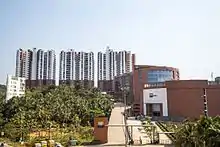 Kozhikode |
1 | Thiruvananthapuram | Thiruvananthapuram district | 968,990 | 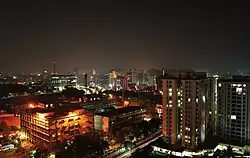 Kochi 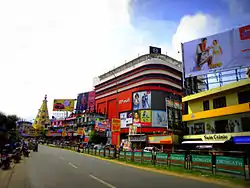 Kollam | ||||
| 2 | Kozhikode | Kozhikode district | 609,224 | ||||||
| 3 | Kochi | Ernakulam district | 602,046 | ||||||
| 4 | Kollam | Kollam district | 388,288 | ||||||
| 5 | Thrissur | Thrissur district | 315,957 | ||||||
| 6 | Kannur | Kannur district | 232,486 | ||||||
| 7 | Alappuzha | Alappuzha district | 180,856 | ||||||
| 8 | Kottayam | Kottayam district | 138,283 | ||||||
| 9 | Palakkad | Palakkad district | 131,019 | ||||||
| 10 | Manjeri | Malappuram district | 97,102 | ||||||
The above table lists Kerala cities in terms of their respective corporation statistics.
According to the 2011 Census, 7 of the top 50 most populous metropolitan areas in India belong to Kerala. They are Kochi, Kozhikode, Thrissur, Malappuram, Thiruvananthapuram, Kannur and Kollam ranking 17, 19, 21, 25, 26, 27 and 48 respectively.[33][31]
The surprising aspect in these corporation numbers are that Kochi Corporation, despite being inside the state's largest urban agglomeration, is only the 2nd most populous and 4th largest in terms of area in the state. This anomaly is because the corporation limits have not been updated since its formation in 1967, and thus expansion of these outdated limits has become a big demand in Kochi.[36]
However, since cities are ranked in terms of their Urban Agglomeration statistics and not in terms of Local self governing bodies statistics (as seen in the Ministry of Housing and Urban Affairs (MOHUA) official rankings[37]), Kochi secures the number 1 spot in the state in terms of largest cities as one can observe below.
Most populous urban agglomerations
The following is a list of most populous urban agglomerations in the Kerala state of India. Population statistics indicated are as of 2011 census.[38][39][40]
(Note that this is a list of metropolitan (UA) population and does not indicate the corporation populations. Cities in India are officially ranked in terms of these numbers)
| Rank | UA | Population (2011) | Population (2001) | District |
|---|---|---|---|---|
| 1 | Kochi | 2,117,990 | 1,355,972 | Ernakulam |
| 2 | Kozhikode | 2,030,519 | 715,681 | Kozhikode |
| 3 | Thrissur | 1,854,783 | 103,122 | Thrissur |
| 4 | Malappuram | 1,698,645 | 170,409 | Malappuram |
| 5 | Thiruvananthapuram | 1,679,754 | 1,089,635 | Thiruvananthapuram |
| 6 | Kannur | 1,642,892 | 498,207 | Kannur |
| 7 | Kollam | 1,110,005 | 380,091 | Kollam |
| 8 | Cherthala | 455,408 | 141,558 | Alappuzha |
| 9 | Kayamkulam | 427,091 | 68,585 | Alappuzha |
| 10 | Kottayam | 357,533 | 172,878 | Kottayam |
| 11 | Palakkad | 293,566 | 283,369 | Palakkad |
| 12 | Alappuzha | 241,072 | 282,675 | Alappuzha |
| 13 | Ottappalam | 238,238 | 49,242 | Palakkad |
| 14 | Kanhangad | 229,706 | 129,367 | Kasaragod |
| 15 | Kasaragod | 192,761 | 75,968 | Kasaragod |
| 16 | Changanassery | 127,971 | 51,967 | Kottayam |
| 17 | Chalakkudy | 114,901 | 48,380 | Thrissur |
| 18 | Kothamangalam | 114,574 | 37,173 | Ernakulam |
Ethnic groups
The vast majority of residents of Kerala are Malayalis, but there are many smaller ethnic groups including Tuluvas, Tamils, Kannadigas and Konkanis. In addition, as of early 2013 there are close to 2.5 million (7.5% of state population) migrant workers from other states of India in Kerala.[41]
Language
Kerala is the most unilingual state of India in which about 97% of the total population speak Malayalam as their Native language.[42] In addition, there is a significant Tamil population in Idukki district, which accounts for 17.48% of its total population.[43] Tulu and Kannada are spoken in the northern portions of Kasaragod district, each of which account for 8.77% and 4.23% of total population in the district respectively.[43][44]
Religion
Hindus constitute 54.7% of the population of Kerala, followed by Islam with 26.6% population and Christianity at third with 18.4% population as per 2011 census.
| Census Year |
Hindus | Decadal Growth rate (%) | Muslims | Decadal Growth rate (%) | Christians | Decadal Growth rate (%) | Total Population |
Decadal Growth rate (%) | ||||
|---|---|---|---|---|---|---|---|---|---|---|---|---|
| 1901 | 4,378,305 | 68.5% | N/A | 1,119,473 | 17.5% | N/A | 891,767 | 13.9% | N/A | 6,389,545 | 100.0% | N/A |
| 1911 | 4,762,393 | 66.8% | +8.77 | 1,263,602 | 17.7% | +12.87 | 1,101,289 | 15.5% | +23.50 | 7,127,284 | 100.0% | +11.55 |
| 1921 | 5,052,039 | 64.9% | +6.08 | 1,360,180 | 17.5% | +7.64 | 1,376,354 | 17.7% | +24.98 | 7,788,573 | 100.0% | +9.28 |
| 1931 | 6,021,982 | 63.4% | +19.20 | 1,624,112 | 17.1% | +19.40 | 1,856,024 | 19.5% | +34.85 | 9,502,118 | 100.0% | +22.00 |
| 1941 | 6,699,600 | 61.8% | +11.25 | 1,883,786 | 17.4% | +11.60 | 2,263,888 | 20.9% | +21.98 | 10,847,274 | 100.0% | +14.16 |
| 1951 | 8,344,351 | 61.6% | +24.55 | 2,374,598 | 17.5% | +26.05 | 2,825,720 | 20.9% | +24.82 | 13,544,669 | 100.0% | +24.87 |
| 1961 | 10,282,568 | 60.9% | +23.23 | 3,027,639 | 17.9% | +27.50 | 3,587,365 | 21.2% | +26.95 | 16,897,572 | 100.0% | +24.75 |
| 1971 | 12,683,277 | 59.4% | +23.35 | 4,162,718 | 19.5% | +37.49 | 4,494,089 | 21.1% | +25.28 | 21,340,084 | 100.0% | +26.29 |
| 1981 | 14,801,347 | 58.2% | +16.70 | 5,409,687 | 21.3% | +30.00 | 5,233,865 | 20.6% | +16.46 | 25,444,899 | 100.0% | +19.24 |
| 1991 | 16,668,587 | 57.3% | +12.62 | 6,788,354 | 23.3% | +25.49 | 5,621,510 | 19.3% | +7.41 | 29,078,451 | 100.0% | +14.28 |
| 2001 | 17,920,105 | 56.3% | +7.51 | 7,863,842 | 24.7% | +15.84 | 6,057,427 | 19.0% | +7.75 | 31,841,374 | 100.0% | +9.50 |
| 2011 | 18,282,492 | 54.9% | +2.02 | 8,873,472 | 26.6% | +12.84 | 6,141,269 | 18.4% | +1.38 | 33,406,061 | 100.0% | +4.91 |
| Indicates Least growth rate | Indicates Most growth rate | Source: Census of India (1901–2011) | ||||||||||
| Religion | 2001[47] | % | 2011[48] | % |
|---|---|---|---|---|
| Hinduism | 17,883,449 | 56.16 | 18,282,492 | 54.73 |
| Islam | 7,863,842 | 24.70 | 8,873,472 | 26.56 |
| Christianity | 6,057,427 | 19.02 | 6,141,269 | 18.38 |
| Buddhism | 2,027 | >0.01 | 4,752 | 0.01 |
| Jainism | 4,528 | 0.01 | 4,489 | 0.01 |
| Sikhism | 2,762 | >0.01 | 3,814 | 0.01 |
| Other | 2,256 | >0.01 | 7,618 | 0.02 |
| Not stated | — | — | 88,155 | 0.26 |
| Total | 31,841,374 | ~100 | 33,406,061 | ~100 |
Religious demographics of Travancore (1816–1941)
| Census year | Hindus | Christians | Muslims | Total population | |||
|---|---|---|---|---|---|---|---|
| 1816 – 1820 | 752,371 | 82.99% | 112,158 | 12.37% | 42,058 | 4.64% | 906,587 |
| 1881 | 1,755,610 | 73.12% | 498,542 | 20.76% | 146,909 | 6.12% | 2,401,158 |
| 1891 | 1,871,864 | 73.18% | 526,911 | 20.60% | 158,823 | 6.21% | 2,557,736 |
| 1901 | 2,063,798 | 69.91% | 697,387 | 23.62% | 190,566 | 6.46% | 2,952,157 |
| 1911 | 2,298,390 | 67.03% | 903,868 | 26.36% | 226,617 | 6.61% | 3,428,975 |
| 1921 | 2,562,301 | 63.96% | 1,172,934 | 29.27% | 270,478 | 6.75% | 4,006,062 |
| 1931 | 3,137,795 | 61.57% | 1,604,475 | 31.46% | 353,274 | 6.93% | 5,095,973 |
| 1941 | 3,671,480 | 60.49% | 1,963,808 | 32.35% | 434,150 | 7.15% | 6,070,018 |
Religious Demographics of Malabar District (1871–1951)
| Religion | 1871 | 1951 | |
| 1 | Hinduism | 72.43% | 63.25% |
|---|---|---|---|
| 2 | Islam | 25.72% | 33.49% |
| 3 | Christianity | 1.43% | 3.24% |
Communities
Caste/communities of Kerala (2011)
Castes of Kerala
The Scheduled Caste (SC) population of Kerala State is 3,123,941 which is 9.8% of overall population. Scheduled Tribes in Kerala, with a population of 364,000, constitute 1.14% of the population.[55]
Denominations groups among Christians:[56]
Catholic church (Syrian and Latin rites) is the largest denomination among Kerala Christians. Malankara orthodox church, Jacobite Syrian orthodox church and Marthomite Syrian church denominations claim Syrian roots. Major Protestant groups include Church of South India (CSI), various Pentecostal churches. Chaldean Syrian, Seventh Day Adventists, Salvation Army are some other denominations.[57][58][59][60][61][62]
Tribal communities
Kerala has approximately 35 distinct scheduled tribes that constitute 1.3% of the population. Though entirely unique, their languages are often not highlighted as distinct in the census. The Paniyan, who are the numerically dominant tribe, live in north east of the state and practice settled cultivation. The Kattunaikan, Kurichian and Kuruman belong to the same region. Palleyan, Palliyan and Palliyar inhabit the Idukki region not far from the Anamalai and Palani hills of Tamil Nadu where you find the same population. The Kadar, Irular, Kurumbas, Maha malasar and Malasar inhabit the Palghat region close to their counterparts in Niligiri and Anamalai hills of Tamil Nadu. The same is the case of the Kudiya and Koraga living in the northern most tip of the state next to Kodagu and Dakshina Kannada region of Karnataka.[63]
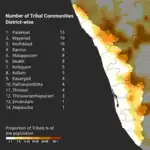 Total number of tribal communities
Total number of tribal communities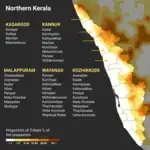 Tribes of North Kerala
Tribes of North Kerala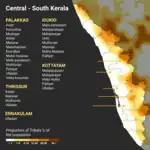 Tribes of Central-South Kerala
Tribes of Central-South Kerala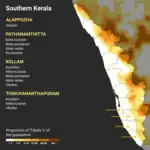 Tribes of South Kerala
Tribes of South Kerala
Age structure
.png.webp)
(2011 census)
- 0–6 years: 9.95%
- 7–14 years: 23.9%
- 15–59 years: 54.3%
- 60 years and over:12.8%
| Age (Years): | Male population | Female population |
|---|---|---|
| 0–4 | 1247534 | 1205558 |
| 5–9 | 1303190 | 1251922 |
| 10–14 | 1438917 | 1383853 |
| 15–19 | 1328299 | 1282253 |
| 20–24 | 1298826 | 1366983 |
| 25–29 | 1203978 | 1400114 |
| 30–34 | 1128217 | 1327284 |
| 35–39 | 1161819 | 1417854 |
| 40–44 | 1117424 | 1295074 |
| 45–49 | 1105598 | 1242932 |
| 50–54 | 931191 | 996954 |
| 55–59 | 861527 | 880881 |
| 60–64 | 685136 | 729535 |
| 65–69 | 459232 | 542902 |
| 70–74 | 326562 | 406810 |
| 75–79 | 208317 | 293050 |
| 80+ | 204348 | 337501 |
| Year: | 1961 | 1971 | 1981 | 1991 | 2001 | 2011 |
|---|---|---|---|---|---|---|
| Age: | 19.28 | 19.39 | 21.81 | 24.36 | 28.87 | 32 |
Urbanisation
| Year | Rural
population (%) |
Urban
Population (%) |
|---|---|---|
| 1961 | 84.9 | 15.11 |
| 1971 | 83.76 | 16.24 |
| 1981 | 81.26 | 18.74 |
| 1991 | 73.61 | 26.39 |
| 2001 | 74.04 | 25.96 |
| 2011 | 52.26 | 47.74 |
Birth rate
| Year | Births | Deaths | Natural change | Birth rate | Death rate | N. change rate |
|---|---|---|---|---|---|---|
| 1997 | 607,727 | 166,428 | 441,299 | 19.2 | 5.3 | 13.9 |
| 1998 | 591,508 | 185,788 | 405,720 | 18.4 | 5.8 | 12.6 |
| 1999 | 596,948 | 186,828 | 410,120 | 18.3 | 5.7 | 12.6 |
| 2000 | 593,724 | 178,795 | 414,929 | 18.0 | 5.4 | 12.6 |
| 2001 | 579,063 | 182,059 | 397,004 | 18.1 | 5.7 | 12.4 |
| 2002 | 581,925 | 184,597 | 397,328 | 18.0 | 5.7 | 12.3 |
| 2003 | 558,369 | 194,264 | 364,105 | 17.2 | 6.0 | 11.2 |
| 2004 | 563,153 | 199,017 | 364,136 | 17.1 | 6.1 | 11.0 |
| 2005 | 559,082 | 204,157 | 354,925 | 17.3 | 6.3 | 11.0 |
| 2006 | 556,326 | 219,094 | 337,232 | 16.6 | 6.6 | 10.0 |
| 2007 | 545,154 | 238,691 | 306,463 | 16.2 | 7.1 | 9.1 |
| 2008 | 535,738 | 221,769 | 313,969 | 15.7 | 6.5 | 9.2 |
| 2009 | 544,348 | 238,691 | 305,657 | 16.2 | 7.1 | 9.1 |
| 2010 | 546,964 | 238,864 | 308,100 | 15.8 | 6.9 | 8.9 |
| 2011 | 560,268 | 245,002 | 315,266 | 16.7 | 7.3 | 9.4 |
| 2012 | 550,411 | 239,982 | 310,429 | 16.4 | 7.1 | 9.3 |
| 2013 | 536,352 | 260,915 | 276,157 | 15.9 | 7.7 | 8.2 |
| 2014 | 534,458 | 248,242 | 286,216 | 15.8 | 7.3 | 8.5 |
| 2015 | 516,013 | 252,576 | 263,437 | 15.1 | 7.4 | 7.7 |
| 2016 | 496,292 | 256,130 | 240,162 | 14.5 | 7.5 | 7.0 |
| 2017 | 503,588 | 263,342 | 240,246 | 14.6 | 7.6 | 7.0 |
| 2018 | 488,174 | 258,530 | 229,644 | 14.1 | 7.5 | 6.6 |
| 2019 | 480,113 | 270,567 | 209,546 | 13.8 | 7.8 | 6.0 |
| 2020 | 446,891 | 250,983 | 195,908 | 12.8 | 7.2 | 5.6 |
| 2021 | 419,767 | 339,648 | 80,119 | 11.9 | 9.7 | 2.3 |
- Birth data by religion
| Religion | 2021[65] | % | 2020[66] | % | 2019[67] | % | 2018[68] | % | 2017[69] | % | 2016[70] | % | 2015[71] | % | 2014[72] | % | 2013[73] | % | 2012[74] | % | 2011[75] | % | 2010[76] | % | 2009[77] | % | 2008[78] | % | 2007[79] | % | 2006[80] | % | 2005[81] | % |
|---|---|---|---|---|---|---|---|---|---|---|---|---|---|---|---|---|---|---|---|---|---|---|---|---|---|---|---|---|---|---|---|---|---|---|
| Muslim | 169,296 | 40.33% | 196,138 | 43.89% | 212,933 | 44.35% | 213,805 | 43.80% | 216,525 | 43.00% | 211,182 | 42.55% | 213,865 | 41.45% | 218,437 | 40.87% | 214,257 | 39.96% | 175,892 | 31.96% | 214,099 | 38.21% | 209,276 | 38.26% | 204,711 | 37.61% | 194,583 | 36.32% | 183,796 | 33.71% | 196,493 | 35.32% | 191,675 | 34.28% |
| Hindu | 181,396 | 43.21% | 185,411 | 41.49% | 197,061 | 41.04% | 203,158 | 41.61% | 210,071 | 41.71% | 207,831 | 41.88% | 221,220 | 42.87% | 231,031 | 43.23% | 236,420 | 44.08% | 214,591 | 38.99% | 248,610 | 44.37% | 246,297 | 45.03% | 247,707 | 45.51% | 241,305 | 45.04% | 250,094 | 45.88% | 258,119 | 46.40% | 262,976 | 47.04% |
| Christian | 59,766 | 14.24% | 62,265 | 13.93% | 68,596 | 14.29% | 69,844 | 14.31% | 75,335 | 14.96% | 76,205 | 15.35% | 79,565 | 15.42% | 83,616 | 15.65% | 84,660 | 15.78% | 102,546 | 18.63% | 94,664 | 16.90% | 88,936 | 16.26% | 90,451 | 16.62% | 94,175 | 17.58% | 98,220 | 18.02% | 96,469 | 17.34% | 98,353 | 17.59% |
| Others | 9,143 | 2.18% | 2,967 | 0.66% | 1,408 | 0.29% | 1,214 | 0.25% | 1,497 | 0.30% | 852 | 0.18% | 933 | 0.18% | 1,178 | 0.22% | 869 | 0.16% | 57,215 | 10.39% | 2,671 | 0.48% | 651 | 0.12% | 704 | 0.13% | 5,151 | 0.96% | 6,108 | 1.12% | 1,545 | 0.28% | 1,098 | 0.19% |
| Not Stated | 166 | 0.04% | 110 | 0.02% | 115 | 0.02% | 153 | 0.03% | 169 | 0.03% | 222 | 0.04% | 430 | 0.08% | 196 | 0.03% | 146 | 0.02% | 167 | 0.03% | 224 | 0.04% | 1,806 | 0.33% | 775 | 0.14% | 524 | 0.10% | 6,936 | 1.27% | 3,700 | 0.66% | 4,980 | 0.89% |
| Total | 419,767 | 100% | 446,891 | 100% | 480,113 | 100% | 488,174 | 100% | 503,588 | 100% | 496,292 | 100% | 516,013 | 100% | 534,458 | 100% | 536,352 | 100% | 550,411 | 100% | 560,268 | 100% | 546,964 | 100% | 544,348 | 100% | 535,738 | 100% | 545,154 | 100% | 556,326 | 100% | 559,082 | 100% |
17.1 births/1,000 population (1994–2001 est.)[82]
Birth Rate was 17.1 in 1994–2001 (20.3 in 1984–1990 & 25.0 in 1974–1980). Pathanamthitta (14.5 in 1994–2001, 17.2 in 1984–1990 & NA in 1974–1980) had the lowest TBR and Malappuram(22.4, 29.5 & 33.6) had the highest TBR.
According to the 2011 Census, Thiruvalla taluk has the lowest birth rate and Tirurangadi taluk has the highest birth rate.[83]
Lowest Birth Rate (2011):
- Thiruvalla – 10.63 per 1,000
- Mallappally – 10.69 per 1,000
- Kozhenchery – 10.86 per 1,000
- Chengannur – 10.93 per 1,000
- Adoor – 11.09 per 1,000
Highest Birth Rate (2011):
- Tirurangadi – 19.99 per 1,000
- Ernad – 19.68 per 1,000
- Perinthalmanna – 19.43 per 1,000
- Tirur – 19.16 per 1,000
- Nilambur – 18.34 per 1,000
Vital stats for the year 2011:[84]
| Community | Pop | Births | Birth Rate | Deaths | Death Rate | NGR% |
|---|---|---|---|---|---|---|
| Total | 33,406,061 | 560,268 | 16.77 | 245,002 | 7.33 | 0.94% |
| Hindu | 18,282,492 | 248,610 | 13.60 | 148,097 | 8.10 | 0.55% |
| Muslim | 8,873,472 | 214,099 | 24.13 | 45,305 | 5.11 | 1.90% |
| Christian | 6,141,269 | 94,664 | 15.41 | 50,365 | 8.20 | 0.72% |
- In 2007, 61.55% of the deaths were reported from Hindus, 17.50% from Muslims and, 19.75% from Christians.[85]
- In 2008, 61.01% of the deaths were reported from Hindus, 17.82% from Muslims and, 20.06% from Christians.[86]
- In 2010, 60.79% of the deaths were reported from Hindus, 18.31% from Muslims and, 20.36% from Christians.[87]
- In 2011, 60.45% of the deaths were reported from Hindus, 18.48% from Muslims and, 20.56% from Christians.[84]
- In 2018, 60.54% of the deaths were reported from Hindus, 19.15% from Muslims and, 19.86% from Christians.[68]
Net migration rate
- (-)3.1 migrant(s)/1,000 population (1991 est.)
Of the emigrants from Kerala, 42.2% were Muslims, 36.6% were Hindus and 21.2% were Christians in 1992–93. The most preferred destination was Saudi Arabia (37.8%), followed by UAE (25.9%), Other Gulf countries (13.0%), Oman (11.8%), Other Countries (7.5%) and USA(3.8%).[88]
Sex ratio
According to the 2011 census, women outnumber men in all the districts of Kerala with the highest proportion in Kannur and Pathanamthitta districts.
| Districts | Population | Males | % | Females | % |
|---|---|---|---|---|---|
| Kasargod | 1,307,375 | 628,613 | 48.1% | 678,762 | 51.9% |
| Kannur | 2,523,003 | 1,181,446 | 46.8% | 1,341,557 | 53.2% |
| Wayanad | 817,420 | 401,684 | 49.1% | 415,736 | 50.9% |
| Kozhikode | 3,086,293 | 1,470,942 | 47.7% | 1,615,351 | 52.3% |
| Malappuram | 4,112,920 | 1,960,328 | 47.7% | 2,152,592 | 52.3% |
| Palakkad | 2,809,934 | 1,359,478 | 48.4% | 1,450,456 | 51.6% |
| Thrissur | 3,121,200 | 1,480,763 | 47.4% | 1,640,437 | 52.6% |
| Ernakulam | 3,282,388 | 1,619,557 | 49.3% | 1,662,831 | 50.7% |
| Idukki | 1,108,974 | 552,808 | 49.8% | 556,166 | 50.2% |
| Kottayam | 1,974,551 | 968,289 | 49% | 1,006,262 | 51% |
| Alappuzha | 2,127,789 | 1,013,142 | 47.6% | 1,114,647 | 52.4% |
| Pathanamthitta | 1,197,412 | 561,716 | 46.8% | 635,696 | 53.2% |
| Kollam | 2,635,375 | 1,246,968 | 47.3% | 1,388,407 | 52.7% |
| Thiruvananthapuram | 3,301,427 | 1,581,678 | 47.9% | 1,719,749 | 52.1% |
Vital statistics
| Year | Infant
Mortality Rate (per 1000 birth) |
Crude
Birth Rate (per 100) |
Crude
Death Rate (per 1000) |
Natural
Growth Rate (per 1000) |
Maternal
Mortality Rate (Maternal death/ 100000 live birth) |
Total
Fertility Rate (Birth/Woman) |
|---|---|---|---|---|---|---|
| 2000 | 14 | 17.9 | 6.4 | 11.5 | 1.7 | |
| 2001 | 11 | 17.3 | 6.6 | 10.7 | 1.8 | |
| 2002 | 10 | 16.9 | 6.4 | 10.5 | 1.8 | |
| 2003 | 11 | 16.7 | 6.3 | 10.4 | 1.8 | |
| 2004 | 12 | 15.2 | 6.1 | 9.1 | 95 | 1.7 |
| 2005 | 14 | 15.0 | 6.4 | 8.6 | 1.7 | |
| 2006 | 15 | 14.9 | 6.7 | 8.2 | 1.7 | |
| 2007 | 13 | 14.7 | 6.8 | 7.9 | 81 | 1.7 |
| 2008 | 12 | 14.6 | 6.6 | 8.0 | 1.7 | |
| 2009 | 12 | 14.7 | 6.8 | 7.9 | 1.7 | |
| 2010 | 13 | 14.8 | 7.0 | 7.8 | 66 | 1.7 |
| 2011 | 12 | 15.2 | 7.0 | 8.2 | 61 | 1.7 |
| 2012 | 12 | 14.9 | 6.9 | 8.0 | 1.7 | |
| 2013 | 12 | 14.7 | 6.9 | 7.8 | 1.6 | |
| 2014 | 12 | 14.8 | 6.6 | 8.2 | 46 | 1.6 |
| 2015 | 12 | 14.8 | 6.6 | 8.2 | 42 | 1.6 |
| 2016 | 10 | 14.3 | 7.6 | 6.7 | 1.7 | |
| 2017 | 10 | 14.2 | 6.8 | 7.4 | 1.7 | |
| 2018 | 7 | 13.9 | 6.9 | 7.0 | 31 (est) | 1.8 |
Life expectancy at birth
Life expectancy at birth is 78 years.[89]
In 1991, Kerala had the lowest TFR (Children born per women) in the whole of India. Hindus had a TFR of 1.66, Christians had 1.78 and Muslims had 2.97. In 2000, the TFR was 1.73 with Muslims having 2.28, Nairs having a TFR of 1.47 and Syrian Christians having TFR of 1.55. TFR for Scheduled Castes was 1.52 in 1997–98 and 1.37 in 1992–93. The lowest Fertility rate recorded anywhere in India is TFR of 1.17 for Vettuvan caste in Kerala.[90]
As per the 2011 Census, the fertility rate per community is as Hindu: 1.544 children per woman, Muslim: 2.351 and Christian: 1.716. For SC, the fertility is 1.485 and for ST, it is 1.629.[91]
For Hindus, the TFR is highest in Wayanad (1.710) and lowest in Thiruvananthapuram (1.435). For the Muslims, it is Kannur (2.779) and Pathanamthitta (1.707), while for the Christians the respective districts are Kasaragod (1.929) and Kollam (1.539).[91]
See also
References
- Western Influence on Malayalam Language and Literature by K. M. George, p2, ISBN 81-260-0413-4 Google book
- Caste, Class and Catholicism in India 1789–1914 by Kenneth Ballhatchet, p2, ISBN 0-7007-1095-7
- (Kalathil 2004, p. 10).
- (Kalathil 2004, p. 12).
- (Kalathil 2004, pp. 13–14).
- (Kalathil 2004, pp. 30–32).
- (Kalathil 2004, p. 37).
- (Kalathil 2004, p. 39).
- Heller, Patrick (June 1996). "Social capital as a product of class mobilization and state intervention: Industrial workers in Kerala, India". World Development. 24 (6): 1055–1071. doi:10.1016/0305-750X(96)00015-0.
- (GOK 2001)
- "Census of India : Provisional Population Totals India : Paper1 : Census 2011". Censusindia.gov.in. Retrieved 16 August 2014.
- R Ramesh; R Purvaja; A Senthil Vel. Shoreline change assessment for Kerala coast (PDF). National Centre for Sustainable Coastal Management, Ministry of Environment and Forests. Retrieved 30 May 2015.
- "Level of Urbanisation in Indian States". mohua.gov.in. Ministry of Housing and Urban Affairs, Government of India.
- "Indian Census". Censusindia.gov.in. Retrieved 20 November 2014.
- Edna Fernandes, The Last Jews of Kerala, Skyhorse Publishing, 2008
- "Population of Kerala - StatisticsTimes.com". statisticstimes.com. Retrieved 23 May 2020.
- "Census 2011, Malappuram" (PDF). censusindia.gov.in.
- R Ramesh; R Purvaja; A Senthil Vel. Shoreline change assessment for Kerala coast (PDF). National Centre for Sustainable Coastal Management, Ministry of Environment and Forests.
- Varma, A.R. Rajaraja (2005). Keralapanineeyam. Kottayam: D C Books. ISBN 81-7130-672-1.
- "Census 2011: Chapter 6 State of Literacy". www.censusindia.gov.in. Archived from the original on 3 September 2013.
- http://ncrb.nic.in/StatPublications/ADSI/ADSI2015/chapter-2%2520suicides-v1.pdf&ved=0ahUKEwibmOS41p_XAhUBLo8KHVjhCeUQFgh7MAk&usg=AOvVaw1qQ89yX7CZ0QKT6J9VigMn
- "Census of India Website : Office of the Registrar General & Census Commissioner, India". censusindia.gov.in.
- "| NITI Aayog". Niti.gov.in. 25 April 2022. Retrieved 7 May 2022.
- (McKibben 1999).
- "Migration From Kerala Growing Steadily, Shows Study". Daijiworld.com. Retrieved 16 August 2014.
- "A Gulf without Keralites could soon be a reality". Emirates 24/7. 18 October 2012. Retrieved 16 August 2014.
- "Invisible people". www.frontlineonnet.com. Archived from the original on 31 January 2011.
- "In Migrants' Own Country". The Indian Express. 24 July 2011. Retrieved 16 August 2014.
- "No Malayalam please, we're Bongs". The Telegraph (India). Retrieved 12 June 2020.
- Rakesh, K.M. (20 April 2011). "Missing voters". The Telegraph. Kolkata, India. Archived from the original on 2 November 2012.
- "Cities of India – statewise". govemployees.in. Archived from the original on 25 August 2016. Retrieved 14 May 2021.
- "3 of world's 10 fastest-growing urban areas are in Kerala: Economist ranking". 8 January 2020. Retrieved 13 January 2020.
- "Urban centres of Kerala". kerala.gov.in. Archived from the original on 30 December 2020. Retrieved 14 May 2021.
- "One in 3 Keralites lives in big cities". The Times of India. 28 October 2011. Archived from the original on 26 January 2013.
- "Provisional Population Totals, Census of India 2011" (PDF). Population of the urban local bodies in Kerala (2011). Government of Kerala. Retrieved 4 December 2020.
- "Chamber calls for expansion of Kochi Corp".
- "आवासन और शहरी कार्य मंत्रालय, भारत सरकार". Mohua.gov.in. Retrieved 7 May 2022.
- "ALPHABETICAL LIST OF TOWNS AND THEIR POPULATION" (PDF). Retrieved 22 September 2023.
- "Population Analysis with list of UAs and their Population" (PDF). Retrieved 22 September 2023.
- "Analysis of Census Date : 2011" (PDF). Censusindia.gov.in. Retrieved 20 May 2015.
- "Migrant worker population in Kerala touches 2.5 m | Business Line". Business Line. Press Trust of India. 16 February 2013. Retrieved 16 August 2014.
- "Language – India, States and Union Territories" (PDF). Census of India 2011. Office of the Registrar General. pp. 13–14.
- "Census of India – Language". censusindia.gov.in.
- "Kerala government to appoint officer to study issues of linguistic minorities". City: Thiruvananthapuram. The Times of India. TNN. 2 August 2017.
- "Kerala: Muslims will be double the number of Christians by 2051". 16 March 2016.
- Photo imgur.com
- "Total population by religious communities". Censusindia.gov.in. Archived from the original on 19 January 2008. Retrieved 20 November 2014.
- "Indian Census 2011". Census Department, Government of India. Archived from the original on 13 September 2015. Retrieved 25 August 2015.
- Census of India, 1931, VOLUME XXVIII, Travancore, Part-I Report (PDF). Thiruvananthapuram: Government of Travancore. 1932. pp. 327, 331.
- Report on the Census of Travancore (1881) (PDF). Thiruvananthapuram: Government of India. 1884. pp. 135, 258.
- Report on the Census of Travancore (1891) (PDF). Chennai: Government of India. 1894. pp. 10–11, 683.
- Travancore, Part I, Vol-XXV (1941) (PDF). Thiruvananthapuram: Government of Travancore. 1942. pp. 124–125.
- Cornish, W. R. (1874). Report on the Census of Madras Presidency – 1871 (PDF). Madras: Government of Madras.
- 1951 census handbook – Malabar district (PDF). Chennai: Government of Madras. 1953.
- Census Tables censusindia.gov.in
- Denominations are not considered as caste or ethnic groups. Caste groups among Christians, which is a continuation of casteism in Hinduism, runs parallel to denominational divisions. One caste group may be spread over many denominations. One denomination may have more than one caste group in it. A person belonging to a denomination can convert to another denomination.
- "Kerala News : Increase in Muslim population in the State". The Hindu. 23 September 2004. Archived from the original on 14 January 2016. Retrieved 20 November 2014.
- "Guess who's after the Hindu vote in Kerala? (Hint: It's not the BJP)". 10 February 2016.
- Radhakrishnan, M. G. (5 September 2012). "Caste-based organisations NSS, SNDP form Hindu Grand Alliance in Kerala". India Today.
- Shenoy, T. V. R. "The communal polarisation of Kerala's voters". Rediff.
- "Dheevara Sabha calls for redefining minority status". The Hindu. 7 July 2006.
- "Brahmins in India". 5 February 2022.
- "Population of Tribals Percentage of Population - Kerala". 2003. Retrieved 22 May 2022.
- "Vital Statistics Reports". Government of Kerala, Vital Statistics Division Department of Economics & Statistics Thiruvananthapuram. Retrieved 11 June 2023.
- "Annual Vital Statistics Report – 2021, Page Number 98" (PDF). Government of Kerala, Vital Statistics Division, Department of Economics & Statistics, Thiruvananthapuram. Retrieved 30 May 2023.
- "Annual Vital Statistics Report – 2020, Page Number 109" (PDF). Government of Kerala, Vital Statistics Division, Department of Economics & Statistics, Thiruvananthapuram. Retrieved 8 July 2022.
- "Annual Vital Statistics Report – 2019, Page Number 100". Government of Kerala, Vital Statistics Division Department of Economics & Statistics Thiruvananthapuram. Archived from the original (PDF) on 7 June 2016. Retrieved 24 August 2020.
- "Annual Vital Statistics Report – 2018, Page Number 92" (PDF). Government of Kerala, Vital Statistics Division Department of Economics & Statistics Thiruvananthapuram. Archived from the original (PDF) on 2 November 2021. Retrieved 24 August 2020.
- "Annual Vital Statistics Report – 2017, Page Number 90" (PDF). Government of Kerala, Vital Statistics Division Department of Economics & Statistics Thiruvananthapuram. Retrieved 20 June 2019.
- Vital statistics 2016 kerala.gov.in
- "Annual Vital Statistics Report – 2015, Page Number 21" (PDF). Government of Kerala, Vital Statistics Division Department of Economics & Statistics Thiruvananthapuram. Retrieved 24 May 2017.
- "Annual Vital Statistics Report – 2014, Page Number 22" (PDF). Government of Kerala, Vital Statistics Division Department of Economics & Statistics Thiruvananthapuram. Retrieved 1 June 2016.
- "Annual Vital Statistics Report – 2013, Page Number 22" (PDF). Government of Kerala, Vital Statistics Division Department of Economics & Statistics Thiruvananthapuram. Retrieved 1 July 2015.
- "Annual Vital Statistics Report – 2012, Table – 2.7 (a), Page Number 23" (PDF). Government of Kerala, Vital Statistics Division Department of Economics & Statistics Thiruvananthapuram. Archived from the original (PDF) on 20 October 2016. Retrieved 1 November 2014.
- "Annual Vital Statistics Report – 2011, Table – 2.7 (a), Page Number 23" (PDF). Government of Kerala, Vital Statistics Division Department of Economics & Statistics Thiruvananthapuram. Archived from the original (PDF) on 6 February 2017. Retrieved 1 February 2014.
- "Annual Vital Statistics Report – 2010, Table – 2.7 (a), Page Number 23-24" (PDF). Government of Kerala, Vital Statistics Division Department of Economics & Statistics Thiruvananthapuram. Retrieved 1 March 2013.
- "Annual Vital Statistics Report – 2009, Table – 2.7 (a), Page Number 19-20" (PDF). Government of Kerala, Vital Statistics Division Department of Economics & Statistics Thiruvananthapuram. Retrieved 1 October 2011.
- "Annual Vital Statistics Report – 2008, Table – 1.7 (a), Page Number 19-20" (PDF). Government of Kerala, Vital Statistics Division Department of Economics & Statistics Thiruvananthapuram. Retrieved 1 March 2010.
- "Annual Vital Statistics Report – 2007, Table – 1.7 (a), Page Number 16" (PDF). Government of Kerala, Vital Statistics Division Department of Economics & Statistics Thiruvananthapuram. Archived from the original (PDF) on 23 March 2012. Retrieved 1 June 2009.
- "Annual Vital Statistics Report – 2006, Table – 1.7 (a), Page Number 34" (PDF). Government of Kerala, Vital Statistics Division Department of Economics & Statistics Thiruvananthapuram. Archived from the original (PDF) on 26 April 2021. Retrieved 26 August 2020.
- "Annual Vital Statistics Report – 2005, Table – 1.7 (a), Page Number 28" (PDF). Government of Kerala, Vital Statistics Division Department of Economics & Statistics Thiruvananthapuram. Archived from the original (PDF) on 10 January 2020. Retrieved 26 August 2020.
- "Family structure, women's education and work: Re-examining the high status of women in Kerala" (PDF). Archived from the original (PDF) on 10 February 2012. Retrieved 7 May 2022.
- http://www.censusindia.gov.in/2011-prov-results/paper2-vol2/data_files/kerala/PPT2_Tables_2.pdf
- "Annual Vital Statistics Report 2011" (PDF). Ecostat.kerala.gov.in. Retrieved 20 May 2015.
- "Annual Vital Statistics Report 2007" (PDF). Ecostat.kerala.gov.in. Archived from the original (PDF) on 23 March 2012. Retrieved 20 May 2015.
- "Annual Vital Statistics Report 2008" (PDF). Ecostat.kerala.gov.in. Retrieved 20 May 2015.
- "Annual Vital Statistics Report 2010" (PDF). Ecostat.kerala.gov.in. Retrieved 20 May 2015.
- "Profile of Emigrants from India: A comparative study of Kerala and Punjab" (PDF). Archived from the original (PDF) on 28 July 2011. Retrieved 7 May 2022.
- "niti ayog".
- Alagarajan, Manoj (2003). "An Analysis of Fertility Differentials by Religion in Kerala State: A Test of the Interaction Hypothesis". Population Research and Policy Review. 22 (5/6): 557–574. doi:10.1023/B:POPU.0000020963.63244.8c. S2CID 154895913.
- 2011 Census censusindia.gov.in
- Chandran, VP (2018). Mathrubhumi Yearbook Plus – 2019 (Malayalam ed.). Kozhikode: P. V. Chandran, Managing Editor, Mathrubhumi Printing & Publishing Company Limited, Kozhikode.
- "Ranking of districts by Sex Ratio and Population density" (PDF). Government of Kerala. 2001. Archived from the original (PDF) on 15 February 2010.
- Kalathil MJ (2004). Nair PR, Shaji H (eds.). Withering Valli: Alienation, Degradation, and Enslavement of Tribal Women in Attappady (PDF). Kerala Research Programme on Local Level Development. Thiruvananthapuram: Centre for Development Studies. ISBN 978-8187621690. Retrieved 29 December 2008.
- McKibben, Bill (October 1999). "Kerala, India". National Geographic Traveler. Archived from the original on 13 April 2002.